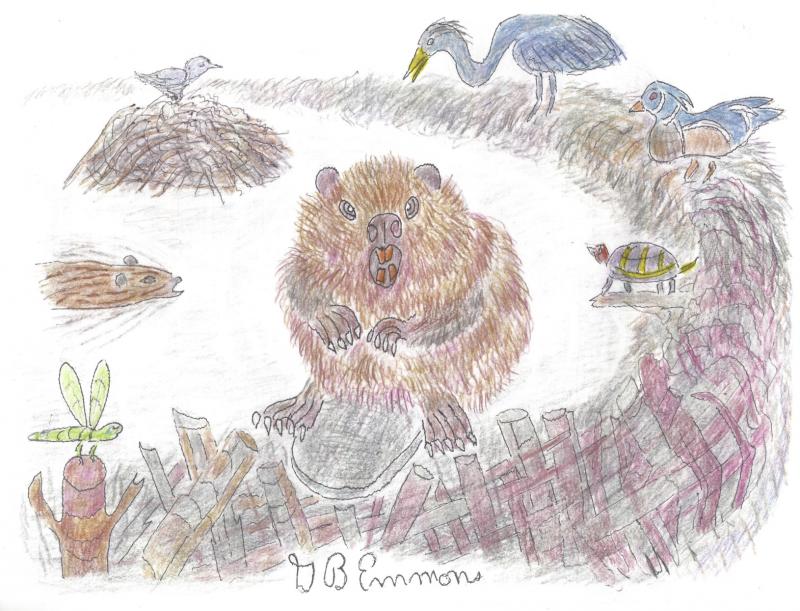The industrious beaver
Reader George B. Emmons of Fairhaven contributes occasional essays about the wildlife of Wareham.
As a Wareham Week reader and coastal resident, you may not see many beavers in your travels unless you go back inland to where their dams are welcomed to be beneficial to both people and wildlife. Out in the country, dams are considered desirable for the environment by slowing down and widening out waterways.
Slow moving flooded habitats make homes for aquatic species such as waterfowl, mammals, turtles, insects, herons and kingfishers — like the one perched on a beaver lodge in my drawing. One benefit of slower moving waters is that they filter out unwanted nitrogen and heavy metal impurities to stop them from spreading downstream.
Important recent research has also discovered that wetlands created by beaver dams stimulate growth of vegetation and aquatic habitat — even in periods of drought — that provides a natural refuge for wildlife during dry season wildfires. Especially on the west coast, dams also catch and conserve a declining amount of glacial melt and act as a wellspring reserve for a future fountainhead of long-term soaking to prevent riparian habitat from drying up entirely.
No other animal has had greater influence on North American continental habitat development than the beaver. The beaver was one of the reasons Europeans colonized the northern continent in the late 1600s and 1700s. The colonizers found beaver pelts were worth more than the spices originally sought by explorers. Trapping and trading with the Native Americans gradually reduced beaver numbers until they were nearly extinct.
When the top hat became very stylish, millions of pelts were shipped to European hat makers to be stretched over frames in a process called felting. The meat from the tails was salted down in wooden barrels and sent to England to be eaten. But it was classified as fish in customs documents for tax purposes. Pelts became so valuable worldwide that both England and France went to war to control the fur trade.
Beavers have also been harvested for a chemical that can be extracted from their bodies called castoreum. Castoreum was used to manufacture perfume as well as a few folk medicines. This demand continued to deplete beaver numbers into the mid-twentieth century, when conservationists realized the beaver population was barely 100,000. Since then, protection and wildlife restoration programs have restored their population to nearly 15 million. Today, there is still some beaver trapping for pelts worth several hundred dollars.
The jury is still out on whether beavers’ presence is an advantage in urban developments. Beaver dams can become a threat and nuisance during rainy periods, as they can flood low-lying drainage and also basements. Additionally, if beavers clog culverts in ditches, adding mesh cages at openings or running a pipe through the dam to limit water flow can be very costly.
Another complaint is that beavers cut down small trees to enjoy their favorite food: the cambial layer between tree bark and the inner layer of wood. Beavers have four razor-sharp front teeth to begin the cut and sixteen back molars to grind wood into a digestible substance. They prefer the flavor of aspen and birch trees, but also choose limbs of willow, oak and hornbeam to fortify the foundations of the dam. Landowners may wrap fencing or metal barriers around tree trunks. Whenever possible, wildlife managers prefer to assist landowners with moving beavers to more suitable habitats.
A beaver’s determination and persistence in constructing a dam sets an example of industrial dedication for the human race in their own projects.












